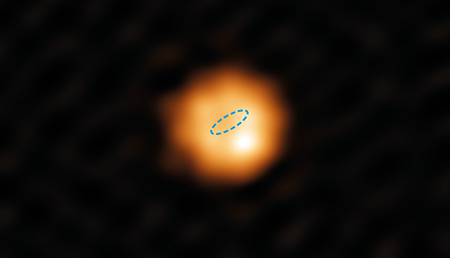First infrared image of a red giant star with a mass of the sun

Astronomers have used the ALMA array in Chile to take the first infrared image of a red giant star that has a mass similar to the Sun.
The dotted ring in the the image, cropped to post here, shows the Earth’s orbit. The star is farther along in its evolution than the Sun, and has expanded as it begins to use up its nuclear fuel.
The observations have also surprised the scientists. The presence of an unexpectedly compact and bright spot provides evidence that the star has surprisingly hot gas in a layer above the star’s surface: a chromosphere. “Our measurements of the bright spot suggest there are powerful shock waves in the star’s atmosphere that reach higher temperatures than are predicted by current theoretical models for AGB stars,” says Theo Khouri, astronomer at Chalmers and member of the team.
An alternative possibility is at least as surprising: that the star was undergoing a giant flare when the observations were made.
The handful of infrared images that astronomers have taken so far of several red giant stars indicates that these stars no longer look like the Sun, with a clear and precise spherical shape, but are puffed up almost like a cloud, with many uneven layers and complex extensions produced by their chaotic nature. This image of W Hydrae reinforces this impression.
On Christmas Eve 1968 three Americans became the first humans to visit another world. What they did to celebrate was unexpected and profound, and will be remembered throughout all human history. Genesis: the Story of Apollo 8, Robert Zimmerman's classic history of humanity's first journey to another world, tells that story, and it is now available as both an ebook and an audiobook, both with a foreword by Valerie Anders and a new introduction by Robert Zimmerman.
The print edition can be purchased at Amazon or from any other book seller. If you want an autographed copy the price is $60 for the hardback and $45 for the paperback, plus $8 shipping for each. Go here for purchasing details. The ebook is available everywhere for $5.99 (before discount) at amazon, or direct from my ebook publisher, ebookit. If you buy it from ebookit you don't support the big tech companies and the author gets a bigger cut much sooner.
The audiobook is also available at all these vendors, and is also free with a 30-day trial membership to Audible.
"Not simply about one mission, [Genesis] is also the history of America's quest for the moon... Zimmerman has done a masterful job of tying disparate events together into a solid account of one of America's greatest human triumphs."--San Antonio Express-News

Astronomers have used the ALMA array in Chile to take the first infrared image of a red giant star that has a mass similar to the Sun.
The dotted ring in the the image, cropped to post here, shows the Earth’s orbit. The star is farther along in its evolution than the Sun, and has expanded as it begins to use up its nuclear fuel.
The observations have also surprised the scientists. The presence of an unexpectedly compact and bright spot provides evidence that the star has surprisingly hot gas in a layer above the star’s surface: a chromosphere. “Our measurements of the bright spot suggest there are powerful shock waves in the star’s atmosphere that reach higher temperatures than are predicted by current theoretical models for AGB stars,” says Theo Khouri, astronomer at Chalmers and member of the team.
An alternative possibility is at least as surprising: that the star was undergoing a giant flare when the observations were made.
The handful of infrared images that astronomers have taken so far of several red giant stars indicates that these stars no longer look like the Sun, with a clear and precise spherical shape, but are puffed up almost like a cloud, with many uneven layers and complex extensions produced by their chaotic nature. This image of W Hydrae reinforces this impression.
On Christmas Eve 1968 three Americans became the first humans to visit another world. What they did to celebrate was unexpected and profound, and will be remembered throughout all human history. Genesis: the Story of Apollo 8, Robert Zimmerman's classic history of humanity's first journey to another world, tells that story, and it is now available as both an ebook and an audiobook, both with a foreword by Valerie Anders and a new introduction by Robert Zimmerman.
The print edition can be purchased at Amazon or from any other book seller. If you want an autographed copy the price is $60 for the hardback and $45 for the paperback, plus $8 shipping for each. Go here for purchasing details. The ebook is available everywhere for $5.99 (before discount) at amazon, or direct from my ebook publisher, ebookit. If you buy it from ebookit you don't support the big tech companies and the author gets a bigger cut much sooner.
The audiobook is also available at all these vendors, and is also free with a 30-day trial membership to Audible.
"Not simply about one mission, [Genesis] is also the history of America's quest for the moon... Zimmerman has done a masterful job of tying disparate events together into a solid account of one of America's greatest human triumphs."--San Antonio Express-News


Kip Thorne is an extreme star fanatic. He has the Thorne-Żytkow type of star named after him. A Red giant that has a neutron star orbiting inside of its photosphere. Something like that. Until they simply disappear from our spacetime. Meanwhile, he will dine with the Swedish princess at his side.
Binary stars are very common and they might even help cause red giants. It isn’t too remote to think that sometimes a white dwarf or other stellar remnant gets into its neighbor as it nova a bit.